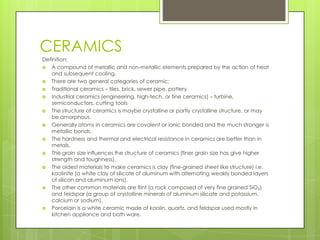
Ceramics
- 1. CERAMICS Definition: A compound of metallic and non-metallic elements prepared by the action of heat and subsequent cooling. There are two general categories of ceramic; Traditional ceramics – tiles, brick, sewer pipe, pottery Industrial ceramics (engineering, high-tech, or fine ceramics) – turbine, semiconductors, cutting tools The structure of ceramics is maybe crystalline or partly crystalline structure, or may be amorphous. Generally atoms in ceramics are covalent or ionic bonded and the much stronger is metallic bonds. The hardness and thermal and electrical resistance in ceramics are better than in metals. The grain size influences the structure of ceramics (finer grain size has give higher strength and toughness). The oldest materials to make ceramics is clay (fine-grained sheet like structure) i.e. kaolinite (a white clay of silicate of aluminum with alternating weakly bonded layers of silicon and aluminum ions). The other common materials are flint (a rock composed of very fine grained SiO₂) and feldspar (a group of crystalline minerals of aluminum silicate and potassium, calcium or sodium). Porcelain is a white ceramic made of kaolin, quartz, and feldspar used mostly in kitchen appliance and bath ware.
- 3. Physical properties Most ceramics have low specific gravity. They also have very high melting or decomposition temperatures. The thermal conductivity of ceramics decrease with increasing temperature and porosity because air is a poor thermal conductor. k = kₒ(1 – P) kₒ = thermal conductivity at zero porosity P = the porosity as a fraction of the total volume Thermal shock or thermal fatigue may be caused by internal stresses formed during thermal expansion and thermal conductivity. Thermal cracking or spalling (a small piece or layer from the surface break off) will not occur when combine with lower thermal expansion and high thermal conductivity. Anisotropy of thermal expansion • that varies with different direction which lead to cracking.
- 4. Alumina Also called corundum or emery Most widely used Used in pure form or as raw material High hardness and moderate strength Alumina + other oxides are used as refractory materials for high-temp applications Suitable as electrical and thermal insulation, cutting tools/abrasives, etc.
- 5. Zirconia Good toughness, good resistance to thermal shock, wear and corrosion Have low friction coefficient Used in hot extrusion die, grinding beads/dispersion media for aerospace coatings, etc. Have thermal stability and low thermal conductivity
- 6. Carbides Made of tungsten and titanium,silicon Examples : Tungsten carbide (WC), titanum carbide (TiC), silicon carbide (SiC)
- 7. Nitrides Cubic boron nitride (CBN) Titanum nitride (TiN) Silicon nitride (Si3N4)
- 8. Glass Amorphous solid Super-cooled liquid (cooled at a rate too high for crystal formation) Content •more than 50% silica (glass former) Types of commercial glasses •¨ sodalime glass (most common), lead alkali glass, borosilicate glass, aluminosilicate glass, 96% silica glass, fused silica glass Thermal classification - hard (greater heat, e.g., borosilicate) or soft glass (e.g., soda lime glass •¨ lampworking)
- 9. Mechanical properties Physical properties Perfectly elastic and Low coefficient of brittle thermal expansion Bulk form has strength High electrical resistivity +/- 140MPa Dielectric strength Strength measurement CTE lower than metals → bending and plastic, may Static fatigue (same approach zero with ceramics)
- 10. Glass ceramics High crystalline microstructure Stronger than glass Shaped and then heat treated Treatment •process known as devitrification(recrystallization of glass) Near •zero coefficient of thermal expansion, high thermal shock resistance
- 11. Graphite Crystalline form of carbon •layered structure Basal planes or sheets of close packed C atoms Weak when sheared along the layers Also known as lampblack •(pigment High electrical and thermal conductivity Good resistance to thermal shock and high temperature
- 12. Types of graphite Fibers •- important use in reinforced plastics and composite materials Foams - high service temperature, chemical inertness, low coefficient of thermal expansion and electrical properties Carbon foams - graphitic or non-graphitic structures Buckyballs - carbon molecules in the shape of soccer balls. Also called fullerents, chemicallyinert, and act like solid lubricant particles
- 13. Diamond Diamond-Like Carbon (DLC) •developed as diamond film coating Can be coated with Ni, Cu, or Ti for improved performance Cutting tools materials (single or polycrystalline) Abrasive in grinding Dressing of grinding wheels (abrasive sharpening) Dies for wire drawing Cutting tools and dies coating
